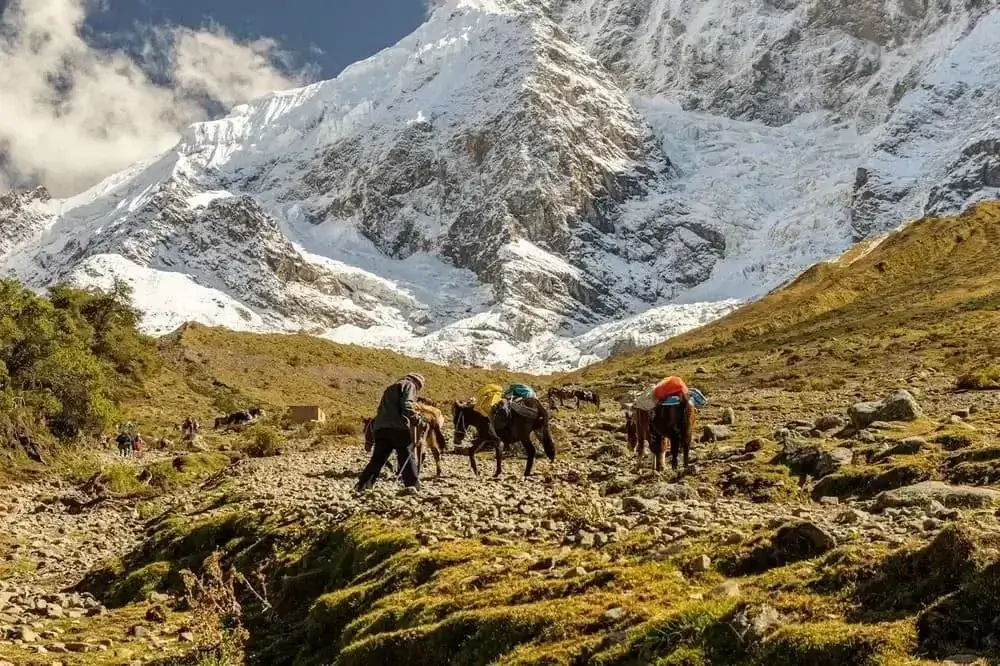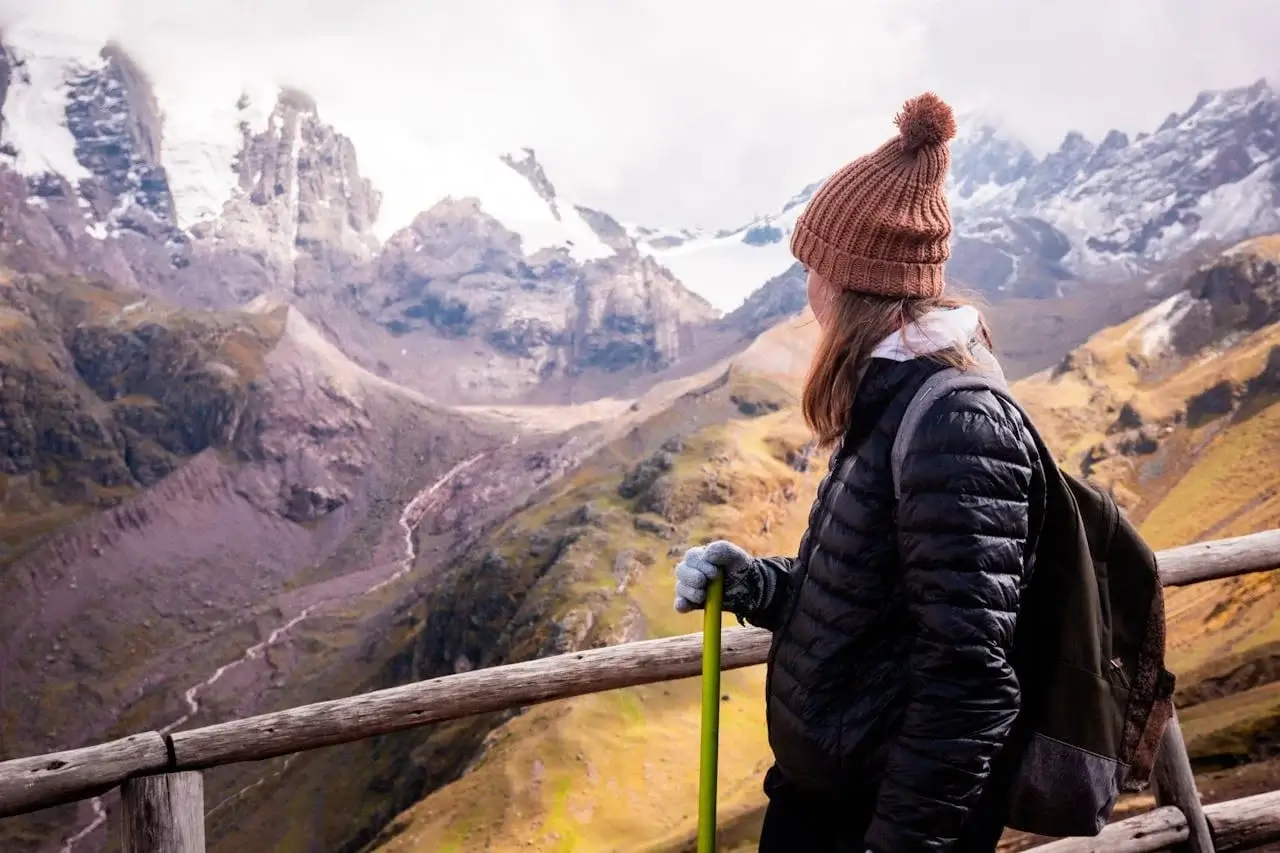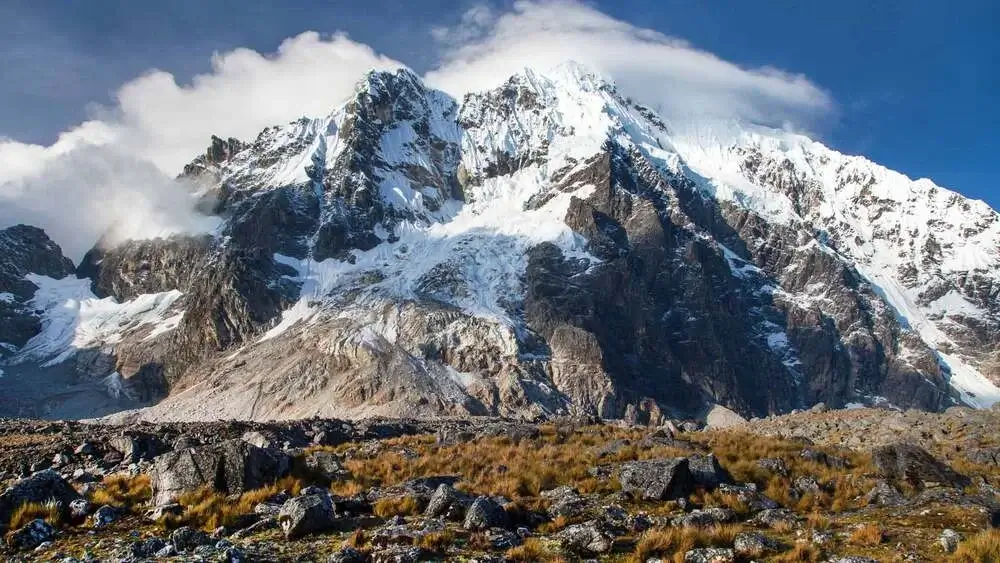High above the Sacred Valley of Peru, Salkantay Mountain rises dramatically to 6,271 meters (20,574 feet). Known as the “Wild Mountain” in Quechua, it is one of the most sacred peaks in Andean cosmology and a dream destination for trekkers heading to Machu Picchu.
Named by National Geographic Adventure Travel as one of the “Top 25 Treks in the World,” the Salkantay Trek offers adventure, breathtaking scenery, and a cultural journey through remote villages and ancient Inca trails.
This blog will guide you through everything you need to know about Salkantay Mountain from its cultural meaning to the trek logistics, tips for preparation, and how it compares to the Inca Trail.
What is Salkantay Mountain?
Quick Facts About Salkantay
- Height: 6,271 m (20,574 ft)
- Location: Cusco region, Peru (Vilcabamba mountain range, Andes)
- Name Meaning: “Salqa” (wild) + “Antay” (avalanche/snowfall) in Quechua → Wild Mountain
- Spiritual Role: Considered an Apu — a sacred guardian spirit of the Andes
- Main Attraction: Gateway to the Salkantay Trek, leading to Machu Picchu
“For the Incas, Salkantay was more than a mountain. It was a living god, protector, and provider.” — Local Quechua saying
Planning a trip to Cusco? Don’t miss the chance to see Salkantay Mountain in all its glory.
Location: Where is Salkantay Mountain?
Salkantay is located in the Cusco region of Peru, about 60 kilometers northwest of the city of Cusco. It is part of the Vilcabamba mountain range, which extends toward the Amazon basin.
- Closest City: Cusco (gateway to Machu Picchu)
- Access Point: Mollepata village (starting point for most treks)
- Nearby Attractions: Sacred Valley, Humantay Lake, Machu Picchu
Read our full blog on How to Avoid Altitude Sickness in Cusco
Cultural Significance: Salkantay as a Sacred Apu
In Andean cosmology, Apus are mountain deities that protect nearby communities. Among them, Salkantay is one of the most powerful Apus, second only to Ausangate.
- Seen as a provider of water and fertile lands.
- Symbol of wildness and untamed natural forces.
- Still honored today through pagos (offerings) by shamans and locals.
“The mountains watch over us. They are alive, and Salkantay is the wildest of all.” — Quechua elder in Mollepata
When trekking Salkantay, respect the land. Local guides often perform small offerings — a unique cultural experience to join.
Flora, Fauna, and Natural Beauty
The trek around Salkantay Mountain passes through five ecosystems, from snow-capped peaks to tropical jungle.
Wildlife Along the Trek
- Andean condor (world’s largest flying bird)
- Spectacled bear (only bear native to South America)
- Hummingbirds, Andean foxes, vizcachas
Flora Highlights
- Ichu grass (high-altitude grassland)
- Polylepis forests (rare Andean trees)
- Orchids (dozens of species in cloud forests)
Takeaway Table:
| Altitude | Ecosystem | Key Features |
|---|---|---|
| 4,500–6,000 m | High Andes | Snow, glaciers, rocky peaks |
| 3,500–4,500 m | Puna grasslands | Ichu grass, condors |
| 2,800–3,500 m | Cloud forest | Orchids, spectacled bear |
| 2,000–2,800 m | High jungle | Coffee, coca, tropical fruits |
Nature lovers will find the Salkantay Trek an unforgettable journey bring binoculars for birdwatching!
The Salkantay Trek: A Complete Guide
The Salkantay Trek is the most famous way to experience Salkantay Mountain. Unlike the Inca Trail, it doesn’t require a government permit, making it a top alternative when permits sell out.
Itinerary (Classic 5 Days)
- Day 1: Cusco → Mollepata → Soraypampa (Humantay Lake optional hike)
- Day 2: Soraypampa → Salkantay Pass (4,650 m) → Chaullay
- Day 3: Chaullay → La Playa (tropical climate)
- Day 4: La Playa → Llactapata → Aguas Calientes
- Day 5: Machu Picchu visit
Distance & Difficulty
- Total Distance: ~72 km (45 miles)
- Duration: 4–5 days
- Difficulty: Moderate to challenging (high altitude, long days)
Bullet Highlights:
- No permits required (unlike the Inca Trail).
- Passes through snow, jungle, and Inca ruins.
- Smaller crowds than the Inca Trail.
Want to lear more about the differences between Salkantay Trek vs. Inca Trail read our full blog here.
Best Time to Trek Salkantay
- Dry Season (Apr–Oct): Clear skies, ideal trekking conditions, but colder nights.
- Rainy Season (Nov–Mar): Lush landscapes, fewer crowds, but muddy trails.
- Best Months: May, June, July (peak season)
Costs: Salkantay Trek 2025
- Group Tours: $400–$650 per person (5D/4N)
- Private Tours: $800+ depending on inclusions
- Luxury Lodge Treks: $2,500+ (Mountain Lodges of Peru)
- Independent Trekking: ~$300 total (guides, meals, gear, transport)
Read more about the Best Hikes in Peru in our Blog.
Packing List for Salkantay Trek
Essentials:
- Trekking boots & walking sticks
- Warm clothing (layers)
- Sleeping bag (rated for -10°C)
Rain jacket
- Sunscreen & sunglasses
- Water purification tablets
- Coca leaves or altitude pills
Pro Tip: Acclimatize in Cusco for at least 2–3 days before trekking.
Salkantay Trek vs. Inca Trail
| Feature | Salkantay Trek | Inca Trail |
|---|---|---|
| Permits | Not required | Required (sell out months ahead) |
| Scenery | Snow + jungle | Ruins + cloud forest |
| Duration | 4–5 days | 4 days |
| Difficulty | Moderate–hard | Moderate |
| Crowds | Less crowded | Popular & busy |
Salkantay Mountain is more than just a peak it is a living guardian of the Andes, a sacred place that combines culture, adventure, and nature in one unforgettable experience.
- Epic views of Peru’s most beautiful landscapes.
- A challenging but rewarding trek to Machu Picchu.
- Deep connection with Andean traditions and spirituality.
Are you ready to experience the magic of Salkantay Mountain for yourself? Whether you’re an adventure seeker, a history enthusiast, or a family searching for a life-changing journey, our team at Andean Travel Experience will design the perfect trek for you.
Plan Your Salkantay Trek Today book with local experts, support sustainable travel, and walk in the footsteps of the Incas.



